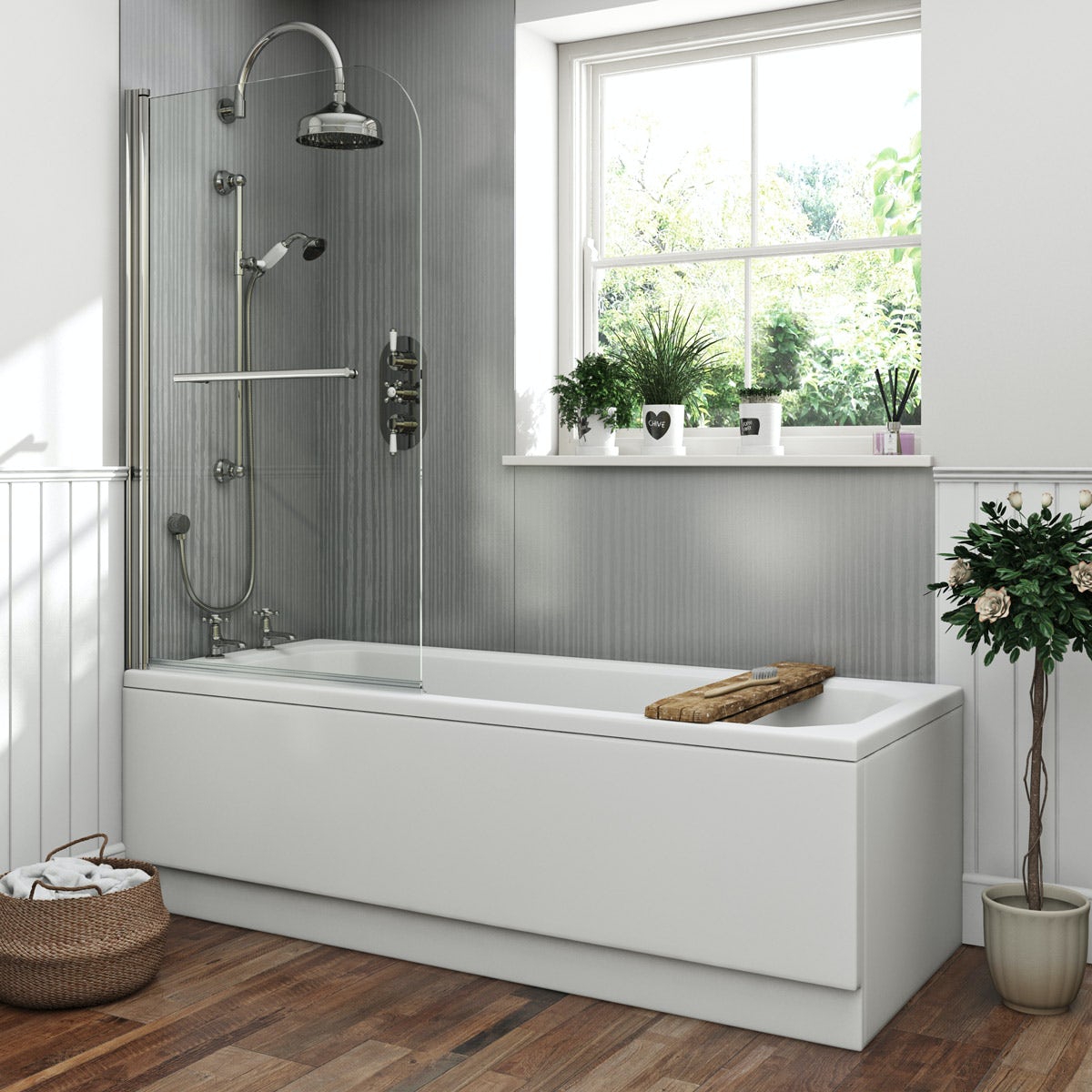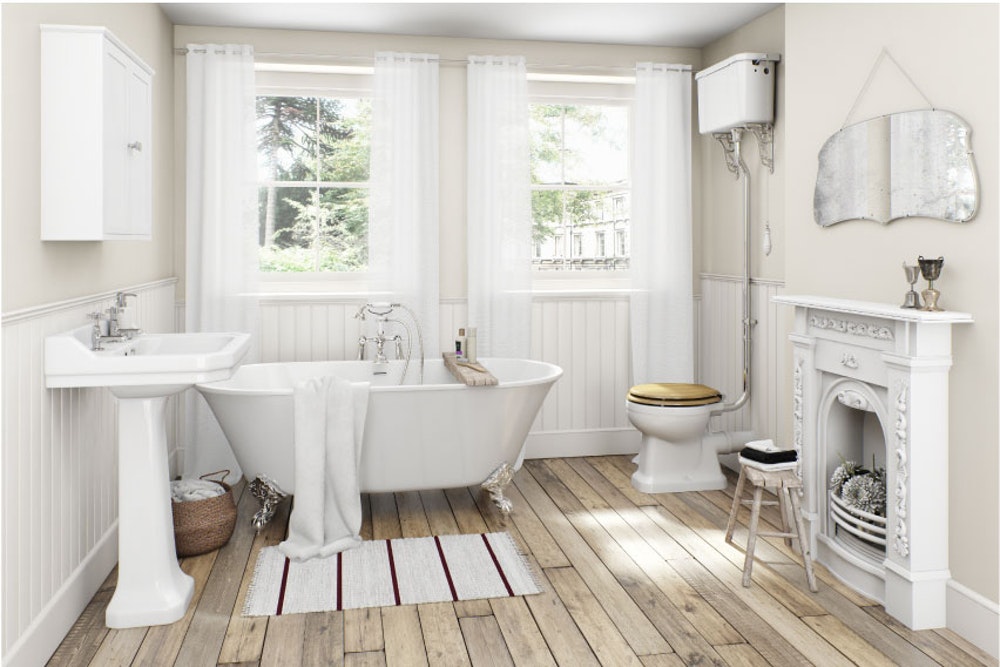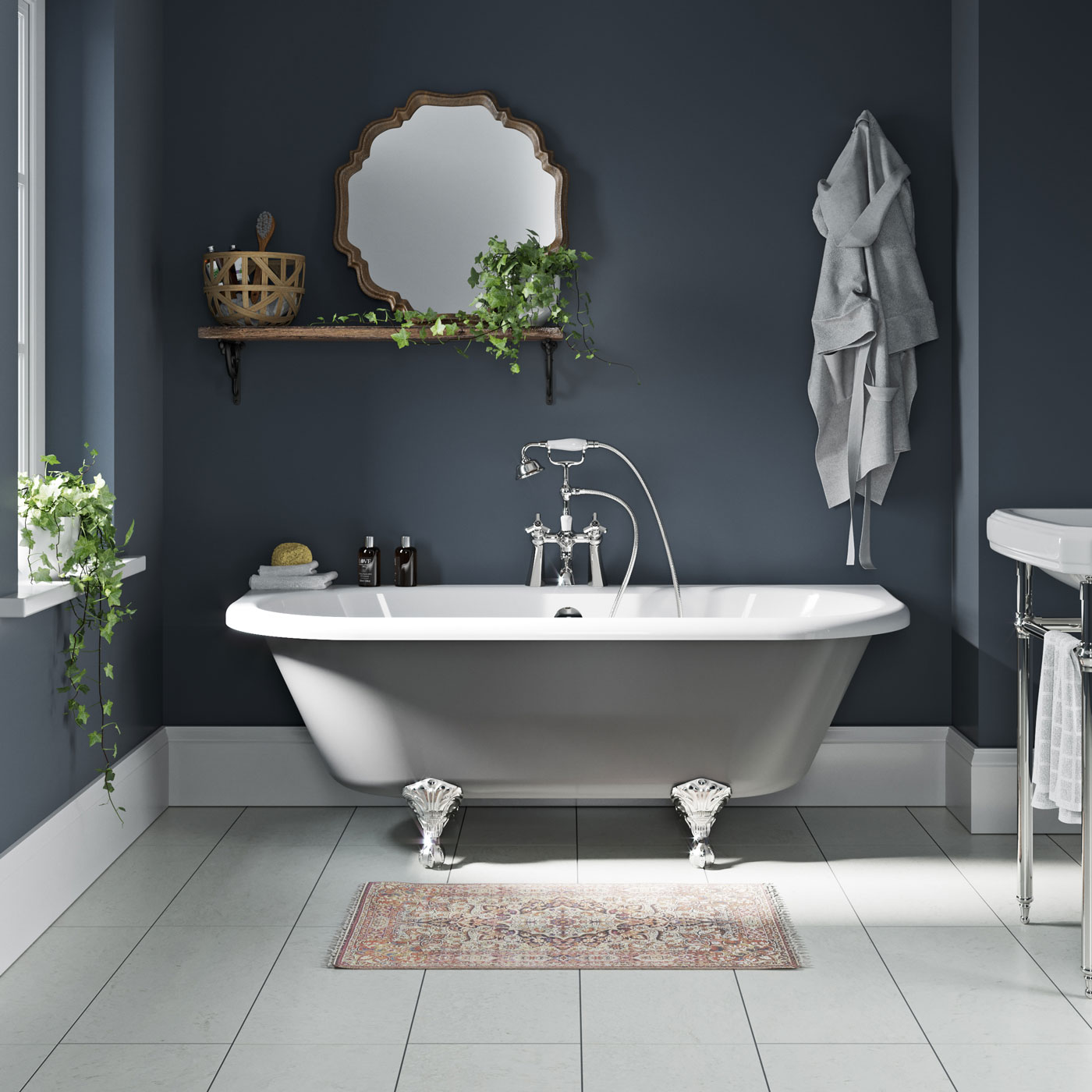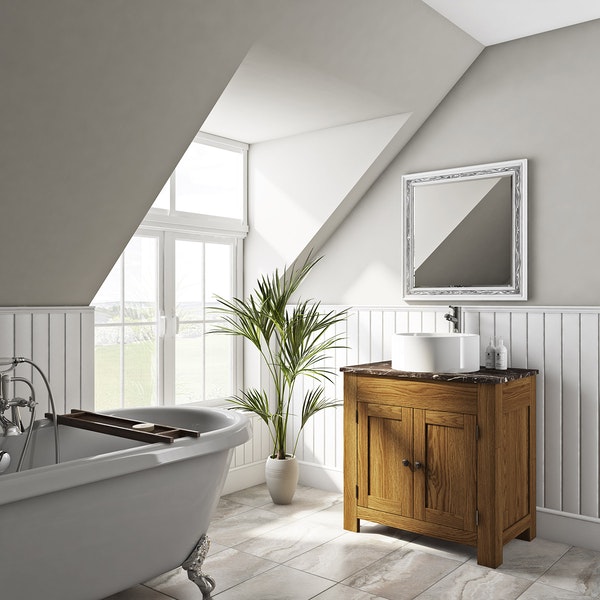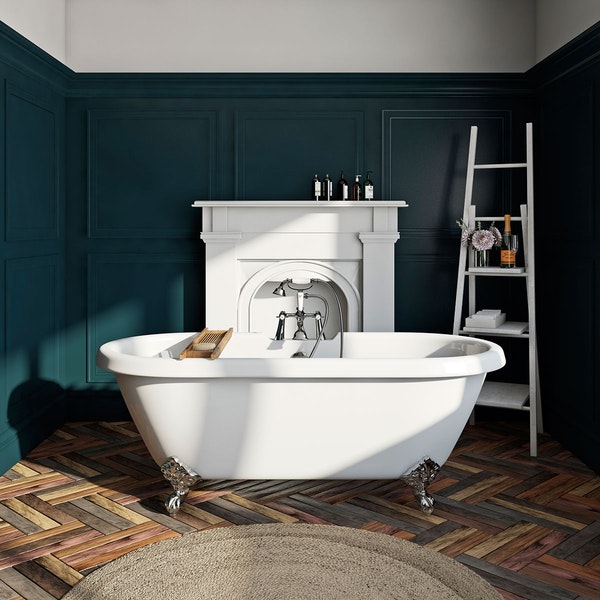Ahh baths — there’s nothing quite like slipping into warm, soothing, blissful waters after a long day. But did you know that not all baths are created equal? Depending on your preferences and needs, not to mention the space and style of your bathroom, there are different types of tubs that are better suited to different households. That’s why we’re diving into bathtub types and benefits to help you find the perfect fit for your home. Let’s get started!
Quick Summary
There are several types of bathtubs, including freestanding tubs, alcove tubs, corner tubs, soak tubs, and corner spa baths. Each type has its own unique advantages, such as providing ample space for relaxation or aesthetic value.
Different Types of Baths
When choosing a type of bathtub for your home, there are several factors to consider. Different types of bathtubs provide different benefits and features that make each model ideal for certain uses. Knowing the differences will help you determine which kind of bathtub is right for you.
The most common types of bathtubs are alcove, freestanding, skirted, corner, and drop-in varieties. An alcove tub is designed to sit in a three-sided enclosure created by walls. This allows for more space but also provides more installation options compared to other types of tubs. Freestanding tubs make a bold statement in the bathroom but require an open area. Skirted tubs typically include panels or wraps around the exterior and are easier to keep clean due to their enclosed design. Corner tubs come in both alcove and freestanding models and fit neatly into small bathrooms. Drop-in tubs feature a high lip around their edges that helps them blend into the surrounding interior decor.
When considering which type of tub to purchase, its important to understand the tradeoffs among them. Alcove tubs are generally cheaper than other options but can be difficult to keep clean due to their exposed walls and lack of enclosure. Freestanding models are beautiful but can be pricey, whereas skirted models can always look sleek but may cost more than other varieties due to their extra paneling detail. Corner and drop-in tubs offer similar styles in different sizes at varying price points so they offer buyers some flexibility when it comes to budgeting.
No matter which type of bathtub you choose, there is sure to be plenty of advantages that accompany it. In the next section we will discuss the many benefits of different types of bathtubs that could potentially suit your home’s needs perfectly.
Benefits of Different Types of Baths
When considering what type of bathtub to buy for a home, it is important to consider the benefits of the various types of tubs that are available. Different types of bathtubs offer different advantages, so understanding these pros and cons is essential in finding the perfect fit for one’s home.
For example, freestanding bathtubs provide a classic and timeless look, making them popular among those with traditional homes. They also provide a unique focal point in bathrooms, drawing attention to themselves instead of other fixtures or surrounding furniture. In addition, freestanding tubs often come with higher walls and deeper bowls than other bathtub types, making them more comfortable.
Walk-in tubs may be a beneficial option for those with disabilities or limited mobility. As the name implies, the step-in design makes entering the tub easier than traditional tubs with high sides. Moreover, they often come equipped with features such as built-in seating, grab bars and water jets that can further enhance accessibility and comfort.
On the other hand, some people find there are downsides associated with stand-alone or walk-in tubs. For one thing, installation can be more complicated due to their individual designs; it typically requires custom measurements and a level floor surface. Additionally, these types of baths usually have shorter lifespans than alcove or corner tubs because parts like pipes may not fit depending on structure and size constraints.
Understanding the various benefits and drawbacks associated with different types of bathtubs can help individuals make an informed decision when selecting the perfect fit for their home. Now that we’ve discussed the advantages of several different bathtub styles, let’s explore standard bathtubs in greater detail in the next section.
Standard Baths
A popular and classic choice, a standard bathtub is an excellent option for many homeowners. It is fit for most bathroom spaces and generally comes in a variety of sizes, styles, and materials. Installing one of these tubs can offer relief from sore muscles due to the deep soaking capability it provides.
Standard baths come in a number of shapes – rectangular, rounded, or corner tubs – giving them an advantage for bathrooms with limited space. Most models also come with safety features like non-slip surfaces and built-in lumbar support so seniors have extra security and comfort when showering or bathing. Overall, standard tubs are easy to maintain, versatile, and offer stylish designs to fit any aesthetic.
On the other hand, some homeowners may be seeking a standout design that will make their bathroom stand out from the regular crowd. Standard bathtubs are recognizable but typically lack that unique look and feel associated with some of the more modern options available today.
Plus, standard tubs require more maintenance than drop-in or walk-in varieties because they’re harder to clean as debris tends to accumulate in the creases where parts connect. This may deter those looking for a low maintenance model.
Next we will explore freestanding bathtubs – a luxurious and increasingly popular option that provides both aesthetics and functionality.
Top Takeaways
Standard bathtubs are a classic and popular choice for many homeowners due to their versatile design and stylish look. They come in a variety of shapes, sizes, materials, and safety features, however they may require more maintenance than other options like drop-in or walk-in tubs. Freestanding bathtubs offer luxury and functionality and are becoming increasingly popular.
Freestanding Bathtub
Freestanding bathtubs are an ideal choice if you want a luxurious, spa-like look to your bathroom. These tubs offer an array of design options, letting you customize the size and shape to fit the space in your bathroom. Freestanding models can stand alone or be claw-footed, which adds height providing a classic look. Many of them are made with lighter materials such as acrylics, making them easier to install than cast iron or other heavy tubs.
However, there are some drawbacks to freestanding styles that need to be considered. The installation process for freestanding tubs can be more complex compared to drop in and alcove models due to inherent factors such as drainage and plumbing considerations, as well as venting requirements. This can result in higher costs for labor and take more time for installation. Additionally, these types of tubs usually do not have built-in shelves or storage compartments like other models which may limit their functional use within the bathroom.
Finally, freestanding bathtubs may require special care over time due to their materials being prone to scratches and staining. Regular maintenance with pH neutral soaps, avoiding harsh chemicals and wiping down the tub after every use with a soft cloth should help reduce potential damage or deterioration associated with most freestanding baths.
Despite these downsides, many people still prefer freestanding bathtubs when it comes to adding an elegant touch and unique focal point to their bathrooms. Now that we’ve discussed the benefits and features of a freestanding bathtub, let us move on to discuss soaking bathtub designs and how they offer additional comfort and relaxation options beyond what traditional freestanding designs offer.
Soaking Baths
Soaking baths offer homeowners a unique and luxurious experience. Designed to provide maximum comfort, soaking tubs can be larger than standard bathtubs and usually consist of a deep-seating area with lumbar support. This provides a stress-relieving environment, perfect for relaxing after a long day. Soaking tubs are designed with extended lengths so that the homeowner can fully immerse their body into the water. Furthermore, many modern soaking tubs come equipped with special features, such as air and water jets that massage your body while you sit in the tub.
While some homeowners may debate the practicality of these luxury items, there are also plenty of benefits to owning a soaking tub. For starters, it’s a great way to indulge in some self-care and take time for yourself during a busy day. In addition to relaxation, soaking in warm water is known to reduce muscle tension and improve circulation in the body. When installed properly, the deep-seated design is extremely waterproof and will not be prone to leaking.
Soaking bathtubs can also be beneficial for people who have difficulty standing or taking showers due to age or medical conditions. By providing them with a safe place to bathe, homeowners can find extra support as they soak in comfort and style.
The next section will discuss one of the smaller versions of bathtubs available: shallow bathtubs. Shallow bathtubs are becoming increasingly popular among homeowners who are tight on space but still want to enjoy all the benefits of a luxury bathing experience.
Shallow Baths
Shallow bathtubs are a great option for those seeking an economic solution to space-saving. The lack of depth makes them practical for small bathrooms or even for master bathrooms with limited space. Not only do these bathtubs provide a functional bathing experience, but the shallowness means they are more comfortable and accessible than deeper tubs. This gives users more flexibility when it comes to body position while bathing, as they can sit up higher and enjoy a more ergonomically correct posture.
One drawback of shallow bathtubs is that they also accommodate far less water than deep bathtubs. This means that anyone who enjoys taking baths needs to consider whether this might be enough water to bathe in. However, depending on the size of the tub and the user’s height, shallow bathtubs can hold enough water to cover at least the lower half of their bodies while they relax and enjoy the luxurious experience of a warm soak.
Another potential disadvantage of shallow bathtubs is that many models cannot accommodate shower heads. This means that users will have to choose between traditional soaking or showering, which may limit their bathing experiences. On the other hand, some manufacturers offer shallow tubs with overhead showers so users can enjoy both options in a smaller space.
Overall, shallow bathtubs are ideal for people looking for a spa-like bathing experience in the comfort of their own homes without sacrificing much space or investing too much money in remodeling projects. For those wanting all the benefits of a deep tub but with greater accessibility or simply less surface area to clean afterward, shallow tubs come highly recommended as a simple and cost-effective solution.
As we move on in our exploration of different types and features of baths, let us now take a closer look at jetted bathtubs to see how they compare and what advantages they bring to your home.
Jetted Baths
Jetted bathtubs provide a luxurious and relaxing bathing experience, employing air or water jets to soothe any muscle aches and pains. The jets create an invigorating massage-like sensation, providing deep relaxation while eliminating toxins from the body. Many jetted tubs are large in size with room for two people to relax together, making them especially popular with couples. In addition, these types of tubs come in a range of materials available such as acrylic, porcelain, cast iron, and stainless steel.
The downside to jetted bathtubs is that they are expensive to buy and install and require more upkeep than other types of tubs. Additionally, the motors that power the jets can be quite loud and jetted baths often make it difficult to soak fully because the jets force you back against the wall of the tub making it difficult to move around freely.
All-in-all, jetted baths offer plenty of benefits for those who have the budget for one and enjoy a massage-like bathing experience. However, as with any type of bathtub purchase considerations must be made regarding cost and upkeep before deciding on this kind of product. Now let’s take a look at another type of tub with its own benefits: hydro jet bathtubs.
Hydro Jet Baths
Hydro jet bathtubs are a relatively new arrival to the tub market but have gained immense popularity in recent years thanks to their various benefits. Hydro jet tubs come equipped with jets that create powerful streams of pressurized water and air, allowing users to enjoy a luxurious and customizable massage experience whenever they utilize the tub. Generally speaking, hydro jet tubs offer more benefits than regular stationary bathtubs, as their jets target deeper muscle layers for a more profound massage effect. As such, hydro jet tubs are excellent for helping alleviate sore joints, muscles and other aches that can be caused by long hours of standing or physical strain.
One of the major advantages attributed to hydro jet bathtubs is their ability to provide an ample amount of relaxation while also being incredibly efficient at cleaning the body. The jets produce water streams that thoroughly remove dirt, sweat, and oils from pores faster than conventional bathing methods. Additionally, hydro jet bathtubs are easy to clean and maintain – simply turn on the jets with nothing but water and glycerin soap to keep it’s interior clean – which makes them a great investment for both convenience and comfort.
In comparison to standard bathtubs, hydro jet tubs also remain warm for much longer periods of time due to its integrated heating system. This allows users to enjoy a longer water massage therapy session without having to worry about cold water temperatures throughout the line-up of jets. While there are some points worth considering regarding hydro jet bathtubs (such as the cost of purchasing and maintaining one), overall these types of tubs offer a number of benefits that make them an attractive investment for homeowners.
Now that we’ve discussed the benefits and techniques associated with hydro jet bathtubs, let’s move onto exploring the different materials these types of tubs are made from in the following section.
The Different Materials Baths Are Made From
When selecting the best bathtub for your home, it is important to consider the various materials available and the associated benefits. Although many bathtubs are made of a combination of different materials, the three most popular materials in modern bathroom designs are enameled cast iron, acrylic, and fiberglass.
Enameled Cast Iron
For traditional bathrooms looking to add a bit of elegance and sophistication, enameled cast iron is an excellent choice. Crafted from real metal, these tubs offer unexpected benefits such as being naturally warmer than any other material. Additionally, their slip resistance porcelain-enamel finish is highly durable and easy to clean. On the downside, these tubs can also be extremely heavy due to their construction and transfer heat more quickly than other tubs making them less energy efficient for hot baths or showers.
Acrylic
Acrylic tubs are lighter than cast iron ones but still provide equal levels of strength and stability. Their non-porous surfaces make them exceptionally easy to clean while they also offer improved insulation helping you stay in the tub longer without having to adjust the water temperature repeatedly. The ease of installation combined with a wide range of shapes and sizes that match almost any room design make acrylic a very flexible option that won’t break the bank. However, more opaque colors often require additional layers of paint which tend to chip over time and can diminish their overall quality.
Fiberglass
Finally, fiberglass tubs are easy to install due to their lightweight nature and flexibility making them a great option for do-it-yourselfers or anyone looking for a quick replacement for their existing tub. They also have an impressive range of vibrant colors and finishes to choose from adding life to an otherwise dull bathroom space. Unfortunately, fiberglass can show signs of wear faster than other materials such as acrylic or cast iron due to its lesser durability compared to those two solutions described above.
As you can see, each type of bathtub has advantages as well as potential disadvantages depending on your needs and desired to look for your home’s bathroom design. Before choosing which one is right for you consider both sides carefully; weighing up factors such as cost, size, and durability along with the aesthetic appeal. With this knowledge in mind, we can now move on to discussing prices and costs associated with different types of bathtubs in our next section.
Price and Cost of Different Types of Baths
When choosing a bathtub, it is important to consider the accompanying cost. Bathtubs come in a wide range of price points and construction materials, making them as expensive or as affordable as you like.
The least expensive option for a bathtub is the traditional enamel steel variety. These tubs start at around $400 or less and are perfect for those on a budget. However, because this material is prone to chipping and cracking with age, it may not be the best long-term option for many homeowners.
On the other end of the spectrum, luxurious freestanding acrylic tubs are available for over $1,500 (or more) depending on size and design features. These tubs boast superior-quality materials and feature a variety of aesthetic enhancements that can add value to your bathroom. Acrylic tubs also come with warranties that protect against defects in workmanship and will provide years of healing hot baths.
For those looking for something in between these two extremes, fiberglass/gel-coated varieties offer an excellent balance between cost and quality. These tubs start out around $400 and go up to around $550 depending on design features such as built-in shelving or seating areas. Fiberglass/Gel-coated models are usually lightweight, durable, easy to maintain and should last up to 15 years with proper care.
Though cost must always be considered when investing in a new bathtub, try not to let it dictate which style you choose entirely. Your bathroom should reflect your tastes as well as your lifestyle, so if one bathtub type matches all three criteria better than another – even if its slightly more expensive – it may be worth investing in the higher quality model for lasting value and pleasure.
Now that you have weighed price and cost considerations for different types of bathtubs, our next section will discuss the installation requirements and considerations you should keep in mind when installing your new unit.
Installation Requirements and Considerations
Installing a bathtub is no small feat. Depending on the type of tub, material and installation method chosen, one must consider the complexity of the project, as well as any associated costs for materials and labor to complete it. Even after deciding what tub is best for your needs, there are many other important factors to consider in order to ensure a successful installation.
The first consideration when installing a bathtub is whether it will require an existing infrastructure or be installed from scratch. If replacing or remodeling an existing water supply line or sewerage line, one may need the services of a licensed plumber to ensure that the project is completed to code. Additionally, depending on the type of tub chosen and given location in the home, extra framing may have to be constructed to support the tub if necessary. It is also important to consider ventilation requirements for bathrooms that don’t already have one installed; otherwise moisture build-up can cause serious health and safety issues.
Installation complexity should also be taken into account when deciding which kind of bathtub is best for you; some materials require more maintenance than others. Acrylic or fiberglass tubs often make installation much simpler due to their lightweight composition. On the other hand, cast iron tubs require more time and resources because of their heavier weight and need for specialized equipment which may increase costs significantly. Ultimately, it is important to weigh all practical considerations with your budget limitations when making purchasing decisions related to installing a bathtub in your home.
When considering the type of bathtub right for you, installation requirements and considerations should always come in to play; choose wisely and ensure all necessary steps are taken to install it correctly so it will last you a lifetime.
Now that we’ve looked at all the different types of bathtubs out there and their associated benefits, let’s take a look at our conclusion in next section.
Conclusion
When it comes to choosing the bathtub that is right for you, there are a variety of different factors to consider. As you weigh your options and decide which one will suit your needs best, remember that each type has its own benefits and depending on your lifestyle and preferences, any one of them could be an ideal fit.
For those wanting customization and extra features, the modern bathtubs offer many different options. They can be made from your choice of materials, come in a number of shapes and sizes and may have additional fixtures like jets or faucets to make bathing even more luxurious.
For those who want both flexibility and convenience, clawfoot tubs offer the benefit of being able to be installed almost anywhere in the home. They come in a variety of styles—from classic designs to more contemporary looks—and are relatively easy to maintain.
If maintaining a spa-like atmosphere while you bathe is what you’re after, soaking tubs may be the perfect fit. These deep-seated tubs are designed for ultimate relaxation—which can help improve overall health and well-being—and they look great too! From drop-in styles to freestanding designs, there is something that can match any bathroom décor.
Whichever type of bathtub you choose, make sure that it is strong enough to support you comfortably and safely as you bathe. Also keep in mind that all types require regular cleaning so it’s important to pay attention to the care instructions based on the material of your chosen style. With all these tips in mind, we hope this article has helped you find the perfect fit for your home!
Common Questions and Explanations
What features should I look for when shopping for a bathtub?
When shopping for a bathtub, it’s important to consider a few key features. First and foremost, think about the size and shape that will fit best in your space. You should also look at the overall design and material of the tub – things like acrylic versus cast iron or steel, or alcove versus freestanding. Consider other features such as seating options, jets, knobs and handles, drains, and faucet holes. In addition, pay attention to the bathtub’s surround – does the tub have a built-in ledge for resting soaps, shampoos and towels? Does it have an included shower curtain or doors to make bathing more comfortable? Finally, make sure you look into the quality of installation – if you don’t do it yourself, make sure any professionals you work with are qualified.
What are the advantages and disadvantages of various bathtub materials?
The main advantages and disadvantages of various bathtub materials come down to their cost, durability, and ease of upkeep.
Acrylic tubs are the most common today, and they offer affordability, versatility, and a range of sizes and shapes. They are often lighter than other material options as well. However, they can scratch or dent easily and will require more frequent cleaning to maintain a spotless finish.
Fiberglass is another affordable material that’s typically easy to install. Fiberglass tubs tend to have a long lifespan but may show wear more quickly than an acrylic tub over time.
Cast iron or porcelain tubs are quite popular for the timeless look they offer in classic bathrooms. Both materials boast great heat retention properties as well as amazing durability provided they are installed properly. The downside of cast iron or porcelain would be the heavy weight of these materials and the higher expense associated with installation.
Finally, solid surface tubs like Cultured Marble can also be a cost-effective option that offers many advantages over standard bathtubs such as resistance to scratches and staining due to its durable surface. Additionally, cultured marble provides superior insulation when compared to other materials which helps keep water warmer while bathing longer. The only disadvantage is the material can dull over time with excessive use of acidic cleaning products.
What are the most common types of bathtubs available on the market?
The most common types of bathtubs available on the market are alcove, drop-in, freestanding and walk-in tubs.
Alcove tubs are the most popular and are typically surrounded by three sides, two walls and a shower curtain or glass door. They are easy to install and fit into any bathroom space with little effort.
Drop-in tubs sit on top of a tiled platform that is built into the floor, allowing for a custom look for your bathroom. You can choose from various shapes and sizes to fit the style of your home.
Freestanding tubs stand alone in your bathroom and can be very stylish. This type of tub comes in various materials such as metal, stone and acrylic. They’re usually larger in size than other bathtubs and require more upkeep than others due to their exposed surfaces.
Walk-in tubs have doors on them rather than steps like traditional bathtubs. They allow users to enter and exit easily, making them great for individuals struggling with mobility issues or those who simply want easier access to their baths. Some come complete with jets, so you can enjoy a calming soak while feeling comfortable and secure.

